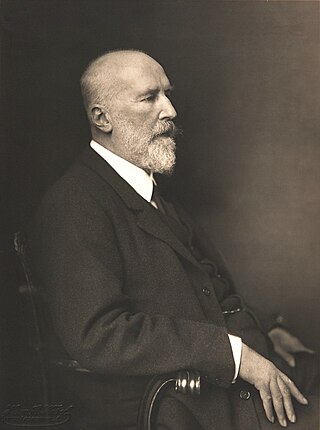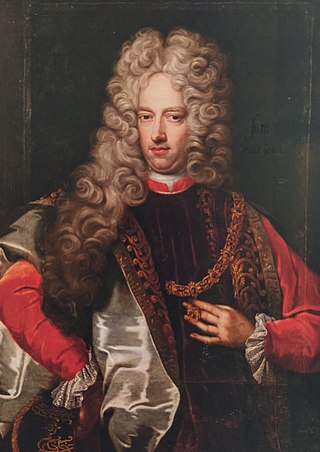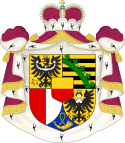
Political identity came to the territory now occupied by the Principality of Liechtenstein in 814, with the formation of the subcountry of Lower Rhætia. Liechtenstein's borders have remained unchanged since 1434, when the Rhine established the border between the Holy Roman Empire and the Swiss cantons.

Hans-Adam II is the Prince of Liechtenstein. He is the son of Prince Franz Joseph II and his wife, Countess Georgina von Wilczek. He also bears the titles Duke of Troppau and Jägerndorf, and Count of Rietberg. Under his reign, a 2003 constitutional referendum expanded the powers of the Prince of Liechtenstein. In 2004, Hans-Adam transferred day-to-day governmental duties to his eldest son Hereditary Prince Alois as regent, like his father had granted him in 1984 to prepare him for the role.

Johann II, nicknamed the Good, was Prince of Liechtenstein from 12 November 1858 until his death in 1929.

Joseph Johann Adam was the Prince of Liechtenstein from 1721 to his death.

Josef Wenzel I, often referred to as just Wenzel, was the Prince of Liechtenstein between 1712 and 1718, and 1748 and 1772, as well as regent of Liechtenstein between 1732 and 1745. He first succeeded his distant cousin Hans-Adam I, even though he was not next in line. The actual heir was his uncle Anton Florian, who was not very popular among the family. Therefore Hans-Adam chose Josef Wenzel as his heir. He later decided to hand over the Principality in exchange for him getting the Dominion of Rumburk in 1718. Thirty years later he inherited Liechtenstein again after his nephew Prince Johann Nepomuk Karl died without male issue. As a military figure, Wenzel is known for his command of the Austrians at the Battle of Piacenza.

Franz Joseph II was the reigning Prince of Liechtenstein from 25 July 1938 until his death in November 1989.

Franz Joseph I, Prince of Liechtenstein, born Franz de Paula Josef Johann Nepomuk Andreas, was the Prince of Liechtenstein from 1772 until his death.

Aloys II was the sovereign Prince of Liechtenstein from 20 April 1836 until his death in 1858. He was a son of Johann I Joseph, Prince of Liechtenstein, and Landgravine Josepha of Fürstenberg-Weitra, and a nephew of Prince Aloys I. Aloys II married Countess Franziska Kinsky of Wchinitz and Tettau and had two sons and three daughters with her, with their two sons later ruling Liechtenstein as Johann II and Franz I. Aloys contributed actively to Liechtenstein's economic and political development.

Franz I was Prince of Liechtenstein from 11 February 1929 until his death in 1938.

The House of Liechtenstein, from which the principality takes its name, is the family which reigns by hereditary right over the principality of Liechtenstein. Only dynastic members of the family are eligible to inherit the throne. The dynasty's membership, rights and responsibilities are defined by a law of the family, which is enforced by the reigning prince and may be altered by vote among the family's dynasts, but which may not be altered by the Government or Parliament of Liechtenstein.
Prince Joseph Wenzel of Liechtenstein, Count of Rietberg is the eldest child of Alois, Hereditary Prince of Liechtenstein, and his wife, Duchess Sophie Elizabeth Marie Gabrielle in Bavaria, He is also the eldest grandchild of the current ruling prince of Liechtenstein, Hans-Adam II, and Countess Marie Kinsky of Wchinitz and Tettau.

Succession to the Liechtensteiner throne is governed by the house laws of the Princely Family of Liechtenstein, which stipulate agnatic primogeniture. In 2004, the head of state, Hans-Adam II, publicly responded to criticism from a committee of the UN which had voiced concerns about the exclusion of women from the line of succession, stating that the rule was older than the state itself.

The Swiss franc has been the currency of Liechtenstein since 1920. The Swiss franc is legal tender since Liechtenstein is in a customs and monetary union with Switzerland. The 1980 treaty between Switzerland and Liechtenstein allows Liechtenstein to mint limited amounts of Swiss francs with a Liechtenstein inscription, but only in the form of commemorative coins, and they are not allowed to issue banknotes.
An order, line or right of succession is the line of individuals necessitated to hold a high office when it becomes vacated, such as head of state or an honour such as a title of nobility. This sequence may be regulated through descent or by statute.
British history provides several opportunities for alternative claimants to the English and later British Crown to arise, and historical scholars have on occasion traced to present times the heirs of those alternative claims.

Prince Emanuel of Liechtenstein was the father and brother to two of Liechtenstein's monarchs.

Archduchess Elisabeth Amalie of Austria was a daughter of Archduke Karl Ludwig of Austria and his third wife Infanta Maria Theresa of Portugal. She was the mother of Franz Joseph II, Prince of Liechtenstein, and the paternal grandmother of Hans-Adam II, Prince of Liechtenstein.

Princess Elsa of Liechtenstein was Princess of Liechtenstein from 1929 to 1938 as the wife of Prince Franz I of Liechtenstein.

Countess Eleonore Barbara Catharina von Thun und Hohenstein was an Austrian noblewoman who, as the wife of Anton Florian, Prince of Liechtenstein, was the Princess of Liechtenstein from 1718 to 1721. She accompanied her husband on diplomatic missions to Rome and Barcelona. After her husband's death in 1721, she spent the remaining two years of her life in Vienna. Her husband was succeeded by their son, Prince Joseph Johann Adam. Eleonore's daughter, Princess Anna Maria, later became Princess consort of Liechtenstein as the wife of Joseph Wenzel I.

John Leopold Donat of Trautson was an Austrian nobleman and politician. Since 1711 he was the first Prince of Trautson, Imperial Count von Falkenstein and Baron zu Sprechenstein. He was educator, chamberlain and Obersthofmeister of Emperor Joseph I.
















